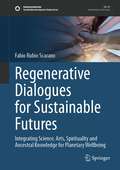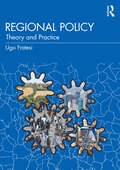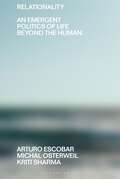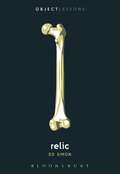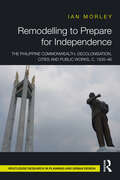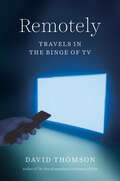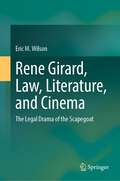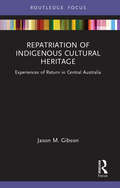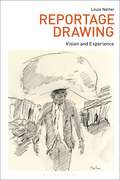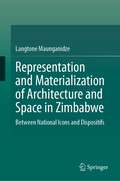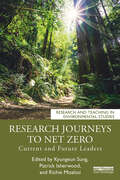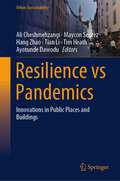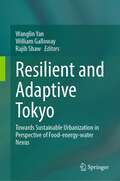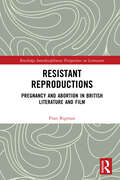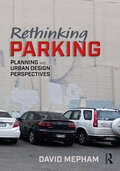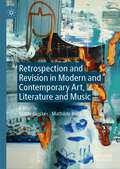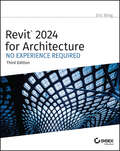- Table View
- List View
Regenerative Dialogues for Sustainable Futures: Integrating Science, Arts, Spirituality and Ancestral Knowledge for Planetary Wellbeing (Sustainable Development Goals Series)
by Fabio ScaranoThis book is about sustainability in its broadest sense. It argues that the ongoing science-policy dialogue on sustainable development (as framed by the United Nations’ Sustainable Development Goals) is insufficient to drive the planet to desired sustainable futures. This conversation, followed by transformative action, must be inclusive of other forms of interpretation of reality (arts, spirituality, and ancestral knowledge) and non-modern cosmovisions. This is more a book about dialogues than about the common dualism problem/solution, and such dialogues are approached as an essential trigger of regeneration. The book takes the reader from a historical perspective of the human-nature relationship through to a discussion on sustainable futures as utopias. The optimism conveyed by the book is justified by a plethora of global examples of such regenerative dialogues.
Regional Policy: Theory and Practice
by Ugo FratesiRegional policy is an essential in any government’s toolkit for promoting socioeconomic prosperity. It comes in many forms and can be used to target the development of weak and stronger regions. This textbook provides comprehensive and systematic coverage of regional policy, dealing with core theories and looking at contemporary challenges in practice, addressing regional policy across the world. Structured in four parts, the book opens with an exploration of regional policy’s characterisation, aims and rationale. The second part is devoted to issues of implementation and the instruments available to policymakers for intervention. The third part addresses regional policy evaluation, as well as statistics and modelling in policymaking. Finally, the book discusses how regional policy is applied in different contexts. Each chapter contains real-life examples of a regional policy topic in action and highlights supplementary topics for advanced readers. With its broad coverage of the subject, Regional Policy: Theory and Practice will prove a valuable resource for advanced students, researchers and practitioners in regional policy, regional economics, economic geography, planning and public policy.
Regional Policy: Theory and Practice
by Ugo FratesiRegional policy is an essential in any government’s toolkit for promoting socioeconomic prosperity. It comes in many forms and can be used to target the development of weak and stronger regions. This textbook provides comprehensive and systematic coverage of regional policy, dealing with core theories and looking at contemporary challenges in practice, addressing regional policy across the world. Structured in four parts, the book opens with an exploration of regional policy’s characterisation, aims and rationale. The second part is devoted to issues of implementation and the instruments available to policymakers for intervention. The third part addresses regional policy evaluation, as well as statistics and modelling in policymaking. Finally, the book discusses how regional policy is applied in different contexts. Each chapter contains real-life examples of a regional policy topic in action and highlights supplementary topics for advanced readers. With its broad coverage of the subject, Regional Policy: Theory and Practice will prove a valuable resource for advanced students, researchers and practitioners in regional policy, regional economics, economic geography, planning and public policy.
Reise ins bekannte Fremde: Ausstellungen japanischer Holzschnitte im Westen vom späten 19. Jahrhundert bis in die Gegenwart (Image #241)
by Marina SammeckJapanische Holzschnitte (ukiyo-e) zählen heute zu den berühmtesten Kunstformen Ostasiens. Doch wie haben die Drucke aus der Edo-Zeit diesen Status erhalten? Als Ursprung für ihren Weltruhm wird häufig auf die Japonismus-Epoche Ende des 19. Jahrhunderts verwiesen. Dabei blenden Kunstwissenschaft und Museumswelt aus, dass die Drucke in den letzten siebzig Jahren vielfach präsentiert wurden. Marina Sammeck verfolgt, wie japanische Holzschnitte durch Ausstellungen und Allianzen zu einer der populärsten japanischen Kunstformen im Westen aufsteigen konnten. Im Mittelpunkt ihrer Analyse steht die Beschreibung des Prozesses, in dem spezifische Objekte zu »Kunst« werden - und was dieser für die zukünftige Ausstellungspraxis bedeutet.
Relationality: An Emergent Politics of Life Beyond the Human (Beyond the Modern)
by Arturo Escobar Michal Osterweil Kriti SharmaThis important new book argues that at the root of the contemporary crisis of climate, energy, food, inequality, and meaning is a certain core presupposition that structures the ways in which we live, think, act and design: the assumption of dualism, or the fundamental separateness of things.The authors contend that the key to constructing livable worlds lies in the cultivation of ways of knowing and acting based on a profound awareness of the fundamental interdependence of everything that exists – what they refer to as relationality. This shift in paradigm is necessary for healing our bodies, ecosystems, cities, and the planet at large. The book follows two interwoven threads of argumentation: on the one hand, it explains and exemplifies the modes of operation and the dire consequences of non-relational living; on the other, it elucidates the nature of relationality and explores how it is embodied in transformative practices in multiple spheres of life.The authors provide an instructive account of the philosophical, scientific, social, and political sources of relational theory and action, with the aim of illuminating the transition from living within seemingly ineluctable 'toxic loops' of unrelational living (based on ontological dualism), to living within 'relational weaves' which we might co-create with multiple human and nonhuman others.
Relic (Object Lessons)
by Dr. Ed SimonObject Lessons is a series of short, beautifully designed books about the hidden lives of ordinary things.Every culture, every religion, every era has enshrined otherwise regular objects with a significance which stretches beyond their literal importance. Whether the bone of a Catholic martyr, the tooth of a Buddhist lama, or the cloak of a Sufi saint, relics are material conduits to the immaterial world. Yet relics aren't just a feature of religion. The exact same sense of the transcendent animates objects of political, historical, and cultural significance.From Abraham Lincoln's death mask to Vladimir Lenin's embalmed corpse, Emily Dickinson's envelopes to Jimi Hendrix's guitar pick, relics are the objects which the faithful understand as being more than just objects. Material things of sacred importance, relics are indicative of a culture's deepest values. Object Lessons is published in partnership with an essay series in The Atlantic.
Remodelling to Prepare for Independence: The Philippine Commonwealth, Decolonisation, Cities and Public Works, c. 1935–46
by Ian MorleyRemodelling to Prepare for Independence: The Philippine Commonwealth, Decolonisation, Cities and Public Works, c. 1935–46 illuminates the implications of the USA’s final phase of colonial rule in the Philippine Islands. It explores the Filipino side of decolonisation and the management of the built environment in the years immediately prior to self-rule. This book shakes off the collaboration vs. resistance paradigm that empire histories generally follow and consequently yields an original vantage point to comprehend transition within an Asian society in the years immediately prior to, during, and after World War Two. This will not only deepen insight of the American Empire, but also grants the opportunity to tie Philippine political-cultural change to the global history of urban planning’s advancement. Accordingly, it opens a new window to rethink Filipino ethno-history and societal evolution, alongside the opportunity to compare the Philippines with other nations that undertook planning projects as part of their decolonisation process and early-postcolonial advancement. The book utilises theoretical frames in order to help creatively excavate the era 1935–46 for the purpose of not just revealing what public works occurred, but to also uncover what those projects meant to the Commonwealth Government, the BPW’s staff, and the public who benefitted from public works projects. The book will be relevant to students and researchers of Urban History, Asian and American (Empire) History, and Imperial and Colonial Studies. Architects, planners, and members of the public who are interested in the form and meaning of urban environments designed/constructed in the past will also find the publication to be of great interest.
Remodelling to Prepare for Independence: The Philippine Commonwealth, Decolonisation, Cities and Public Works, c. 1935–46
by Ian MorleyRemodelling to Prepare for Independence: The Philippine Commonwealth, Decolonisation, Cities and Public Works, c. 1935–46 illuminates the implications of the USA’s final phase of colonial rule in the Philippine Islands. It explores the Filipino side of decolonisation and the management of the built environment in the years immediately prior to self-rule. This book shakes off the collaboration vs. resistance paradigm that empire histories generally follow and consequently yields an original vantage point to comprehend transition within an Asian society in the years immediately prior to, during, and after World War Two. This will not only deepen insight of the American Empire, but also grants the opportunity to tie Philippine political-cultural change to the global history of urban planning’s advancement. Accordingly, it opens a new window to rethink Filipino ethno-history and societal evolution, alongside the opportunity to compare the Philippines with other nations that undertook planning projects as part of their decolonisation process and early-postcolonial advancement. The book utilises theoretical frames in order to help creatively excavate the era 1935–46 for the purpose of not just revealing what public works occurred, but to also uncover what those projects meant to the Commonwealth Government, the BPW’s staff, and the public who benefitted from public works projects. The book will be relevant to students and researchers of Urban History, Asian and American (Empire) History, and Imperial and Colonial Studies. Architects, planners, and members of the public who are interested in the form and meaning of urban environments designed/constructed in the past will also find the publication to be of great interest.
Remotely: Travels in the Binge of TV
by David ThomsonA leading film critic on the evolving world of streaming media and its impact on society The city at night under lockdown, a time of plague and anxiety. It is an exciting new age of television, the light that flutters in every cell in the city. But no one seems to be asking: What is the endless stream doing to us? In Remotely, the most innovative writer on film and screens asks what happened to us as we sought consolation under lockdown by becoming a society of bingeing creatures. From Candid Camera and I Love Lucy to Ozark, Succession, and Chernobyl, David Thomson and his wife, Lucy Gray, wander through shows old and new, trying to pin down the nature and justification for what we call “entertainment.” Funny, mysterious, and warm, at last here is a book that grasps the extent to which television is not just a collection of particular shows—hits and misses—but a weather system in which we are lost pilgrims searching for answers.
Rene Girard, Law, Literature, and Cinema: The Legal Drama of the Scapegoat
by Eric M. WilsonThis book is the first monograph to critically evaluate the work of the literary scholar René Girard from the perspectives of Law and Literature and Law and Film Studies, two of the most multidisciplinary branches of critical legal theory. The central thesis is that Girard’s theory of the scapegoat mechanism provides a wholly new and original means of re-conceptualizing the nature of judicial modernity, which is the belief that modern Law constitutes an internally coherent and exclusively secular form of rationality. The book argues that it is the archaic scapegoat mechanism – the reconciliation of the community through the direction of unified violence against a single victim – that actually works best in explaining all of the outstanding issues of Law and Literature in both of its sub-forms: law-as-literature (the analysis of legal language and practice exemplified by literacy texts) and law-in-literature (the exploration of issues in legaltheory through the fictitious form of the novel). The book will provide readers with: (i) a useful introduction to the most important elements of the work of René Girard; (ii) a greater awareness of the ‘hidden’ nature of legal culture and reasoning within a post-secular age; and (iii) a new understanding of the ‘subversive’ (or ‘enlightening‘) nature of some of the most iconic works on Law in both Literature and Cinema, media which by their nature allow for the expression of truths repressed by formal legal discourse.
Repatriation of Indigenous Cultural Heritage: Experiences of Return in Central Australia (Museums in Focus)
by Jason M. GibsonRepatriation of Indigenous Cultural Heritage examines how returned materials - objects, photographs, audio and manuscripts - are being received and reintegrated into the ongoing social and cultural lives of Aboriginal Australians. Combining a critical examination of the making of these collections with an assessment of their contemporary significance, the book exposes the opportunities and challenges involved in returning cultural heritage for the purposes of maintaining, preserving or reviving cultural practice. Drawing on ethnographic work undertaken with Aboriginal communities and the institutions that hold significant collections, the author reveals important new insights about the impact of return on communities. Technological advances, combined with the push towards decolonising methodologies in Indigenous research, have resulted in considerable interest in ensuring that collections of cultural value are returned to Indigenous communities. Gibson challenges the rhetoric of museum repatriation, arguing that, while it has been tremendously important to advancing Indigenous interest, it is too often over-simplified. Repatriation of Indigenous Cultural Heritage offers a timely, critical perspective on current museum practice and its place within processes of cultural production and transmission. The book is sure to resonate in other international contexts where questions about Indigenous re-engagement and decolonisation strategies are being debated and will be of interest to students and scholars of Museum Studies, Indigenous Studies and Anthropology.
Repatriation of Indigenous Cultural Heritage: Experiences of Return in Central Australia (Museums in Focus)
by Jason M. GibsonRepatriation of Indigenous Cultural Heritage examines how returned materials - objects, photographs, audio and manuscripts - are being received and reintegrated into the ongoing social and cultural lives of Aboriginal Australians. Combining a critical examination of the making of these collections with an assessment of their contemporary significance, the book exposes the opportunities and challenges involved in returning cultural heritage for the purposes of maintaining, preserving or reviving cultural practice. Drawing on ethnographic work undertaken with Aboriginal communities and the institutions that hold significant collections, the author reveals important new insights about the impact of return on communities. Technological advances, combined with the push towards decolonising methodologies in Indigenous research, have resulted in considerable interest in ensuring that collections of cultural value are returned to Indigenous communities. Gibson challenges the rhetoric of museum repatriation, arguing that, while it has been tremendously important to advancing Indigenous interest, it is too often over-simplified. Repatriation of Indigenous Cultural Heritage offers a timely, critical perspective on current museum practice and its place within processes of cultural production and transmission. The book is sure to resonate in other international contexts where questions about Indigenous re-engagement and decolonisation strategies are being debated and will be of interest to students and scholars of Museum Studies, Indigenous Studies and Anthropology.
Reportage Drawing: Vision and Experience (Drawing In)
by Louis NetterHow does drawing shape the truth and our understanding of the visual world? Why has the act of reportage drawing persisted and thrived in our ever-changing media landscape? This book offers a deep dive into the world of reportage drawing, a world which is provocative, mixed media, transdisciplinary and immersed in the idiosyncratic vision of the artist. Where the traditional orientation of reportage was on the communicative function of the image as a record of an event, contemporary practitioners, largely detached from commissioning structures of the 19th and 20th centuries, now seek to capture more experiential qualities of place and choose locations which have highly personal and political significance. Liberated from old conceptions of reportage drawing as objective and true, artists today embrace subjectivity and are seeking a rich dialogue with their subjects, using drawing to tell important stories about protest, human migration, war, corporate capitalism and homelessness. Louis Netter distinguishes contemporary reportage drawing from its historical function through a critical exploration of the aesthetic of the sketch, the role of caricature and the nature of experience. Featuring several prominent artists such as Jill Gibbon, who secretly draws in arms fairs across Europe, Phoebe Glockner, who produces highly provocative mixed media work about violence against women in Mexico, renowned reportage illustrator Gary Embury and French reportage artist Loup Blaster, in addition to an exploration of the author's own work, this book shows how the act of drawing can foster new insights about people, places and political realities in often subtle and challenging ways. Part of the Drawing In series, this book opens up reportage drawing practice as a way of understanding our world in a deeper and more personal way.
Representation and Materialization of Architecture and Space in Zimbabwe: Between National Icons and Dispositifs
by Langtone MaunganidzeThis volume is an empirical study examining the extent to which historic and iconic architecture and spaces in Zimbabwe - particularly in urban areas - have been mobilized to construct and reconstruct identities. The author explores the question of traditional and political architecture through analysis of a variety of structures, including monuments, museums, and indigenous and state buildings. Special attention is paid to the soapstone-carved Zimbabwe Bird, which for years has served as the national emblem. Overall, this book argues that while the production and use of architectural products and spaces have been regarded symbols of collective identity, they have also served as expressions of power and control.
Research Journeys to Net Zero: Current and Future Leaders (Research and Teaching in Environmental Studies)
This book provides useful insight into how academics from diverse disciplinary backgrounds, such as science, engineering, technology, social science, policy, design, architecture, built environment, business, and management, have been conducting research into how to realise net zero emissions to address climate change. This book explores the ways in which countries around the world have pledged to achieve net zero emissions through decarbonisation processes. It presents the highest calibre research and impact activities carried out in the UK, Europe, North America, Australia, Asia, and Africa. Such activities include conceptualisation, opportunity identification, specific case studies, demonstration of proof of concepts, provision of evidence, education of the general public, and knowledge transfer to companies. Further to this, the chapters also bring to light personal career journeys to net zero by current and future international research leaders. From this book, readers will gain a full understanding of net zero research via multiple disciplinary pathways, be inspired by personal accounts, and will learn key methodologies, including quantitative and qualitative approaches. The diversity of authors and topics make the book widely applicable to a range of fields, and it will be of great interest to researchers, students, practitioners, and decision makers working towards the goals of net zero and decarbonisation.
Research Journeys to Net Zero: Current and Future Leaders (Research and Teaching in Environmental Studies)
by Kyungeun Sung Patrick Isherwood Richie MoalosiThis book provides useful insight into how academics from diverse disciplinary backgrounds, such as science, engineering, technology, social science, policy, design, architecture, built environment, business, and management, have been conducting research into how to realise net zero emissions to address climate change. This book explores the ways in which countries around the world have pledged to achieve net zero emissions through decarbonisation processes. It presents the highest calibre research and impact activities carried out in the UK, Europe, North America, Australia, Asia, and Africa. Such activities include conceptualisation, opportunity identification, specific case studies, demonstration of proof of concepts, provision of evidence, education of the general public, and knowledge transfer to companies. Further to this, the chapters also bring to light personal career journeys to net zero by current and future international research leaders. From this book, readers will gain a full understanding of net zero research via multiple disciplinary pathways, be inspired by personal accounts, and will learn key methodologies, including quantitative and qualitative approaches. The diversity of authors and topics make the book widely applicable to a range of fields, and it will be of great interest to researchers, students, practitioners, and decision makers working towards the goals of net zero and decarbonisation.
Resilience vs Pandemics: Innovations in Public Places and Buildings (Urban Sustainability)
by Ali Cheshmehzangi Maycon Sedrez Hang Zhao Tian Li Tim Heath Ayotunde Dawodu“Resilience vs Pandemics: Innovations in Public Places and Buildings” explores innovative solutions for architecture and public places during and after the pandemic. Additionally, the authors contribute to the documentation of architectural and social transformations that have been prompted by previous transmissible diseases, as this knowledge can inform responses to future pandemics. In this volume, the chapters present critical, exploratory, multi- and interdisciplinary, and cutting-edge research approaches; with a particular focus on the effects of COVID-19 and other highly transmissible diseases on the design, use, performance, and perception of the built environment, particularly at the building scale. This volume aims to organize a collection of scientific studies, reviews, analysis, recommendations, and solutions in the fields of urban design, architecture, design, landscape design, etc. The overarching goal is to document new approaches to create and enhance built environment resilience. Chapters shed light on novel methods, tools, processes, regulations, behaviours, and other relevant details contributing to a comprehensive understanding of this crucial issue. The two scales of the built environment under consideration are: (1) Public Places, including research on transformations (death, emergencies, changes), requirements, adaptability, usability, virtual immersion, historical perspectives, interactivity, shifts in use and programs, etc.(2) Buildings, including regulations, shifts in use and program, non-pharmaceutical interventions, human interactions, and human-machine interfaces. The book covers a wide range of studies, including physical and non-physical studies, which may refer to the city infrastructure, green/blue spaces, housing, policy-making, health services, social and economic issues, etc. The findings and results of various global case study examples contribute to the decision-making of governments, organizations, and institutions, as well as inspire scholars and future research for developing resilience in the post-pandemic era.
Resilient and Adaptive Tokyo: Towards Sustainable Urbanization in Perspective of Food-energy-water Nexus
by Wanglin Yan William Galloway Rajib ShawOur cities, and the systems that support them, have not been designed to address the FWE nexus. There exist gaps in awareness of the role and impacts of climate change. Improving communication among stakeholders with the support of scientific evidence is the key to narrowing the gaps. This book approached this issue with a multidisciplinary and transdisciplinary moveable nexus approach through the lens of FEW nexus under the project of the Sustainable Urbanization Global Initiative of Belmont Forum. It presents a collection of evidence/science-based planning decisions and participatory practices by using Tokyo as the focal area. It visualizes the stock and flow of the Food-Water-Energy (FEW) supporting the world’s largest metropolitan area, explores how the actors have worked together to secure the resilience and sustainability of resources, and demonstrates the potential of resources in making the city adaptive to climatic and social changes. It is designed for researchers in urbanization, nexus research, urban design research, environment, disaster risk reduction, and climate change studies, and can be used as a textbook for university courses. It is also a useful tool for practitioners and policymakers in applying collective knowledge to policy and decision-making.
Resistant Reproductions: Pregnancy and Abortion in British Literature and Film (Routledge Interdisciplinary Perspectives on Literature)
by Fran BigmanResistant Reproductions asks why narratives of pregnancy and abortion emerged in the early twentieth century and what kinds of stories these narratives conveyed. Is it only once pregnancy becomes plannable that it becomes a story worth telling? Abortion is often considered resistant and feminist, while pregnancy is considered domestic and conventional. How can readings of literary narratives challenge this reductive binary?Resistant Reproductions, the first book-length study of both pregnancy and abortion in British culture, addresses these questions by examining pregnancy narratives, including abortion narratives, in British fiction and film from 1907 to 1967. Fiction became a way for writers to explore what new possibilities of reproductive control would mean for the individual, yet there was also much anxiety about who would have control: individuals or the state. While exploring intimate personal experiences of pregnancy and abortion, Resistant Reproductions also asks how literary narratives used reproductive plots to address political issues of gender, class, and eugenics.
Resistant Reproductions: Pregnancy and Abortion in British Literature and Film (Routledge Interdisciplinary Perspectives on Literature)
by Fran BigmanResistant Reproductions asks why narratives of pregnancy and abortion emerged in the early twentieth century and what kinds of stories these narratives conveyed. Is it only once pregnancy becomes plannable that it becomes a story worth telling? Abortion is often considered resistant and feminist, while pregnancy is considered domestic and conventional. How can readings of literary narratives challenge this reductive binary?Resistant Reproductions, the first book-length study of both pregnancy and abortion in British culture, addresses these questions by examining pregnancy narratives, including abortion narratives, in British fiction and film from 1907 to 1967. Fiction became a way for writers to explore what new possibilities of reproductive control would mean for the individual, yet there was also much anxiety about who would have control: individuals or the state. While exploring intimate personal experiences of pregnancy and abortion, Resistant Reproductions also asks how literary narratives used reproductive plots to address political issues of gender, class, and eugenics.
Rethinking Parking: Planning and Urban Design Perspectives
by David MephamFor much of the past century, we have viewed the issue of parking from the driver’s seat. It follows that key narratives about parking reaffirm the immediate needs of the driver. A consequence of this approach is a failure to understand the significant damage that parking causes to the destination. That damage is amplified by ‘cheap, easy’ parking at the expense of place and access outcomes. Viewing parking from an urban planning and design perspective highlights different issues and opportunities. Five perspectives are offered: Place – If we gave drivers all the parking they wanted, the destination would not be worth visiting. Politics – Parking is intensely territorial, emotional, and prone to populism, and this is a barrier to strategic and sustainable parking reform. Policy – Parking tends to be focused on the ‘me, here and now’ needs of the driver at the expense of bigger picture and longer term policy objectives. Price – Subsidized parking exists behind opaque pricing mechanisms. In contrast, a transparent accounting of costs is a vehicle for strategic parking reform. Professional practice – Parking is a significant land-use issue, located at the juncture of transport and urban planning and design. Improving urban parking outcomes requires an integrated and collaborative planning process. An alternative view of parking is timely as new technologies and economies fundamentally change everything we understand about parking. A potential paradigm shift is in the making. Rethinking Parking provides a pathway to a better parking/place balance and access to destinations worth visiting. It is valuable reading for students and professionals engaged in transport, planning, urban access, and design.
Rethinking Parking: Planning and Urban Design Perspectives
by David MephamFor much of the past century, we have viewed the issue of parking from the driver’s seat. It follows that key narratives about parking reaffirm the immediate needs of the driver. A consequence of this approach is a failure to understand the significant damage that parking causes to the destination. That damage is amplified by ‘cheap, easy’ parking at the expense of place and access outcomes. Viewing parking from an urban planning and design perspective highlights different issues and opportunities. Five perspectives are offered: Place – If we gave drivers all the parking they wanted, the destination would not be worth visiting. Politics – Parking is intensely territorial, emotional, and prone to populism, and this is a barrier to strategic and sustainable parking reform. Policy – Parking tends to be focused on the ‘me, here and now’ needs of the driver at the expense of bigger picture and longer term policy objectives. Price – Subsidized parking exists behind opaque pricing mechanisms. In contrast, a transparent accounting of costs is a vehicle for strategic parking reform. Professional practice – Parking is a significant land-use issue, located at the juncture of transport and urban planning and design. Improving urban parking outcomes requires an integrated and collaborative planning process. An alternative view of parking is timely as new technologies and economies fundamentally change everything we understand about parking. A potential paradigm shift is in the making. Rethinking Parking provides a pathway to a better parking/place balance and access to destinations worth visiting. It is valuable reading for students and professionals engaged in transport, planning, urban access, and design.
Retrospection and Revision in Modern and Contemporary Art, Literature and Music
by Mette Gieskes Mathilde RozaThis interdisciplinary book investigates the various ways in which North American and European modern and contemporary artists, authors, and musicians have returned to earlier works of their own, engaging in inventive revivals and transformations of the past in the present. The book is distinctive in its focus on such revisits, as well as in the diversity of art forms under review: in addition to visual art, the book explores fiction, poetry, literary criticism, film, rock music, and philosophy. This scope, together with the time-span covered in the book, from the 1850s to the twenty-first century, allows for a broad view on retrospection and revision. The case studies presented here offer a multifaceted exploration of the widely different goals to which practitioners of the arts have made retrospection and revision functional against the background of cultural, social, political, and personal forces.
Revit 2024 for Architecture: No Experience Required
by Eric WingThe latest and most authoritative version of the popular step-by-step tutorial for Revit Architecture The newly revised third edition of Revit 2024 for Architecture: No Experience Required is the latest update to the market-leading, real-world guide for learning and building with Revit—the powerful and sophisticated Building Information Modeling (BIM) software used by professionals around the world. This popular, user-friendly book teaches you the Revit interface and helps you understand the foundational concepts and features of the software. You’ll learn to design, document, and present a 3D BIM project with a continuous, step-by-step tutorial that guides you through every phase of the project: from placing walls, doors, windows, structural elements, dimensions, and text, to generating documentation, advanced detailing, site grading, construction scheduling, material takeoffs, and more. In addition, this book helps you prepare for the Autodesk Revit Architecture Certification Exam. Throughout the book, you will find helpful insights directly related to the exam. The last two chapters are dedicated entirely to the exam with a practice test at the end of the book. You’ll also: Learn each phase of designing, documenting, and presenting a four-story office building using a simple yet engaging continuous tutorial Follow the tutorial sequentially or jump to any chapter by downloading the project files from the Sybex website Use the start-to-finish tutorial project as a reference for your own real-world projects and to develop a powerful Revit skillset Gain thorough knowledge of Revit’s essential concepts and features to make the move from 2D drafting to 3D building information modeling Get up to speed with advanced features, including new coverage of advanced walls, families, sites, topography, and moreThe Autodesk Revit 2024 for Architecture: No Experience Required, 3rd Edition, is the go-to guide for professionals and students seeking to learn Revit’s essential functions quickly and effectively.
Revit 2024 for Architecture: No Experience Required
by Eric WingThe latest and most authoritative version of the popular step-by-step tutorial for Revit Architecture The newly revised third edition of Revit 2024 for Architecture: No Experience Required is the latest update to the market-leading, real-world guide for learning and building with Revit—the powerful and sophisticated Building Information Modeling (BIM) software used by professionals around the world. This popular, user-friendly book teaches you the Revit interface and helps you understand the foundational concepts and features of the software. You’ll learn to design, document, and present a 3D BIM project with a continuous, step-by-step tutorial that guides you through every phase of the project: from placing walls, doors, windows, structural elements, dimensions, and text, to generating documentation, advanced detailing, site grading, construction scheduling, material takeoffs, and more. In addition, this book helps you prepare for the Autodesk Revit Architecture Certification Exam. Throughout the book, you will find helpful insights directly related to the exam. The last two chapters are dedicated entirely to the exam with a practice test at the end of the book. You’ll also: Learn each phase of designing, documenting, and presenting a four-story office building using a simple yet engaging continuous tutorial Follow the tutorial sequentially or jump to any chapter by downloading the project files from the Sybex website Use the start-to-finish tutorial project as a reference for your own real-world projects and to develop a powerful Revit skillset Gain thorough knowledge of Revit’s essential concepts and features to make the move from 2D drafting to 3D building information modeling Get up to speed with advanced features, including new coverage of advanced walls, families, sites, topography, and moreThe Autodesk Revit 2024 for Architecture: No Experience Required, 3rd Edition, is the go-to guide for professionals and students seeking to learn Revit’s essential functions quickly and effectively.
